|
Return to Hiker's Notebook Home Page
Geologic Formation: Chilhowee Group
Chilhowee is a Cherokee word originally in the form Tsu'lunwe'i; the meaning has been lost but it is thought to have been derived from the word for kingfisher or tsu'lu. Another possible etymology is atsi'la a'wi' meaning "fire deer." There is a Chilhowee Mountain in Eastern Tennessee, and a Chilhowee stream in the mountains of southwestern Virginia. It is probable that the grouping was named for its appearance in these locations.
The Chilhowee Group consists of the Weverton, Harpers or Hampton, and Antietam or Erwin Formations (in some areas the Loudoun formation is also included). The formations are considered as consisting of one group since they represent a single geologic continuum that proceeded over a long enough time period for the nature of the rocks to change to the extent that difference in composition became manifest.
The geologic event that resulted in the formation of the Chilhowee Group was the erosion of the proto-Appalachian Mountains during the Cambrian Period (570 to 505 million years ago). According to plate tectonic theory , the North American and Eurasian plates collided about 1.2 billion years ago; the Grenville orogeny causing the initial uplifting of the proto-Appalachian Mountains. As the plates started to move apart, magma extruding from the mantle covered the area with basalt, producing the Catoctin Formation. Continued plate rifting resulted in the Iapetus Ocean. Erosion of the uplifted areas deposited the Weverton, Harpers and Erwin Formations in succession.
The interface between the Catoctin Formation and the Chilhowee Group has been characterized as a transgressive sequence between rift deposits of mafic igneous rock and clastic (composed of broken fragments), metamorphosed sedimentary rocks. The first layer to be deposited was the Weverton Formation, a 100 to 500 foot thick bed of pebbled quartzite with stratified layers of phyllite and metasandstone. The coarseness of the grain is an indication of the riparian origin of the initial formation, the sand, pebbles and gravel accumulating in the initial rivers flowing from the uplifted areas to the newly forming Iapetus Ocean. The Weverton Formation is named for Weverton, Maryland, and forms the main ridge-making formation in Eastern Maryland. Wolf Rock in Catoctin Park (right) is a prime example.
The Hampton or Harpers formation is the second in the sequence of the Chilhowee Group and accounts for about two-thirds of the overall clastic rock deposition with a thickness ranging from about 1,800 to 2,200 feet. It consists of drab, dark layers of phyllite and greenish-gray to brown metasiltstone. The finer grain structure of the formation is characteristic of a littoral deposition in muddy lagoons that were formed as the Iapetus Ocean rose, sand, silt and mud collecting in thick layers. The formation is prevalent in the area around Harper's Ferry (the stairs to "Jefferson Rock" are cut into the cleavage of the bedding planes) from which its name is derived. Blackrock (right) is the most striking example of the formation in Shenandoah National Park.
Siltstone and phyllite are composed of smaller particles than sandstone and signify that the deposition occurred in a quieter environment. This is consistent with the shallow water sedimentation of the Harpers Formation, the silt-sized particles being carried by water to collect offshore. The even smaller particles of mudstone and shale (shale is fissile, it breaks into sheets whereas mudstone is non-fissile) are the basis for phyllite. Shale is metamorphosed into slate which has a slight sheen due to small grains of mica and graphite. Phyllite is metamorphosed shale, the reflective particles having fused such that a glittering surface persists. Phyllite is from the Greek word physis meaning leaf; the cleavage surface that occurs when phyllite is fractured resembles a leaf.
The presence of archetypical shoreline marine fossils in both the Harpers and Erwin Formations supports the geologic explanation for the formation of the Chilhowee Group. Soft-bodied marine worms, as would be found in a muddy lagoon environment, left evidence of their presence in the form of burrows and trails in the metasandstones of the Harpers Formation. These are the earliest indications of Cambrian life in the Blue Ridge Province. The Erwin Formation contains large numbers of vertical worm borings, called Skolithos that are typical of littoral beach environments. These ichnofossils (an indication of the presence of an animal in the absence of a fossil of the body of an animal) formed tubes in the beach sand that are about � inch in diameter and up to 3 feet in length.
The Chilhowee Group was deposited over the course of almost 100 million years as the Iapetus Ocean formed and the proto-Appalachian mountains eroded. About 450 million years ago, in the middle of the Ordovician Period, the North American and Eurasian plates stopped opening and started to close. Through sequences of three orogenies (Taconic, Acadian, and Alleghenian) over the course of 200 million years, the strata were subjected to a series of diastrophic events, producing the folding and faulting that created the Appalachian Mountains and the supercontinent known as Pangea. It persisted for about 50 million years, its breakup resulting in the formation of the Atlantic Ocean and the eroded topography of the coastal plain. |
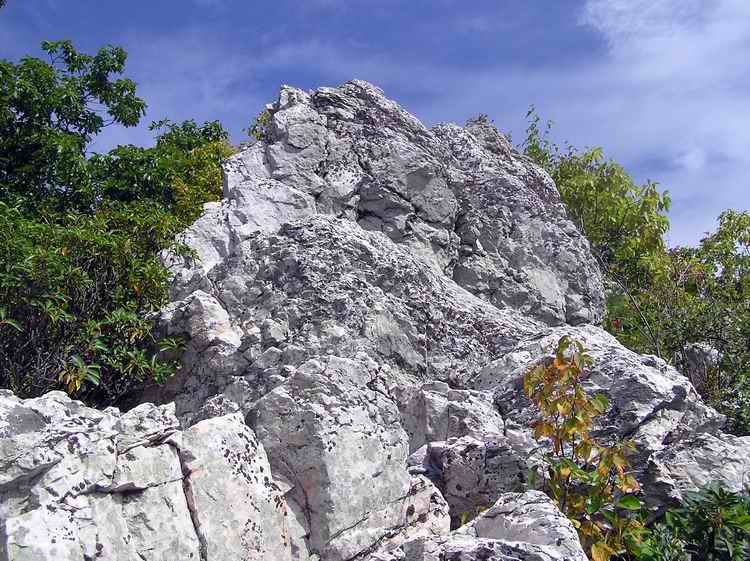
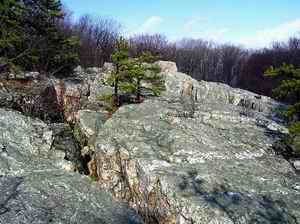
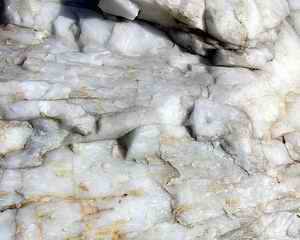 Quartzite
is a tough rock that is derived from sandstone. It can be either sedimentary
or metamorphic according to how it is formed. The sedimentary variety, called
orthoquartzite, is formed at low temperature and pressure by circulating fluid
cementing sand grains with silica cement. Under high pressure and temperature
the silica grains recrystallize so that the original sedimentary structure is
obliterated. This form of quartzite is appropriately called metaquartzite and
is the kind found in the Chilhowee Group formations. Though it is very strong,
it is difficult to work with so it is rarely used in construction, granite
being the preferable hard rock material.
Quartzite
is a tough rock that is derived from sandstone. It can be either sedimentary
or metamorphic according to how it is formed. The sedimentary variety, called
orthoquartzite, is formed at low temperature and pressure by circulating fluid
cementing sand grains with silica cement. Under high pressure and temperature
the silica grains recrystallize so that the original sedimentary structure is
obliterated. This form of quartzite is appropriately called metaquartzite and
is the kind found in the Chilhowee Group formations. Though it is very strong,
it is difficult to work with so it is rarely used in construction, granite
being the preferable hard rock material.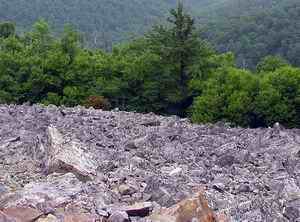
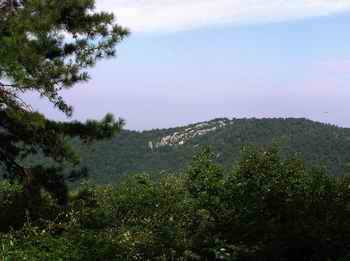 The
Erwin or Antietam Formation is the third and final layer of the Chilhowee
Group, consisting of thick beds of nearly white quartzite that form distinct
cliffs on many of the upper ridges of Shenandoah National Park (left from
Skyline Drive and top above on Brown Mountain). The
geologic sequence that is manifest in the formation is the extension of the
seacoast westward, covering the muddy lagoons that formed the underlying
Harpers Formation with beach sand that accumulated to depths of up to 1,000
feet. The relative purity of the quartzite supports this explanation, as the
nearly pure white silica particles result from neritic wave action that
creates beach sand.
The
Erwin or Antietam Formation is the third and final layer of the Chilhowee
Group, consisting of thick beds of nearly white quartzite that form distinct
cliffs on many of the upper ridges of Shenandoah National Park (left from
Skyline Drive and top above on Brown Mountain). The
geologic sequence that is manifest in the formation is the extension of the
seacoast westward, covering the muddy lagoons that formed the underlying
Harpers Formation with beach sand that accumulated to depths of up to 1,000
feet. The relative purity of the quartzite supports this explanation, as the
nearly pure white silica particles result from neritic wave action that
creates beach sand.